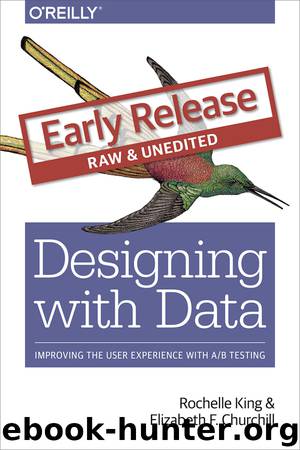Designing with Data by Rochelle King & Elizabeth F. Churchill

Author:Rochelle King & Elizabeth F. Churchill
Language: eng
Format: epub, mobi
Publisher: O’Reilly Media, Inc.
Published: 2015-12-15T16:00:00+00:00
Figure Y: Percentage of actions over time
This visualization shows the relative amounts of time that people spent rewinding, playing, pausing and chatting per session. Clearly this shows that people main action was chatting. However, the more interesting story arose when we looked at the data over time. This is shown in Figure Z. When we first looked at this plot, we looked at actions as pulled from the data server according to what was then a “standard” session. Here the time of a session for the data pull was set to be a certain number of minutes (describe a session). We were curious to see the sharp drop of activity, a sign of low engagement for most end-user applications where action equates to engagement. However, in tandem with activity data and summary action data analysis we were conducting observational studies of users trying Zync. And we made an observation that seems obvious in hindsight, but was not obvious until we did the observational studies: for actions like watching a video, inaction or doing nothing, is a sign of engagement. To put it simply, if you were sitting on a couch watching a video and the person next to you keep chatting, nnin that content and doing nothing. With this insight in hand, we returned to our data and widened the time window for the log analysis, we created a human-activity driven session window rather than a system session window, and we saw something very interesting: the tall spike in activity that you see at the far right of Figure Z. When the video stopped playing, people started chatting, they resumed their engagement with each other. We thus defined a whole new set of methods for determining user engagement with the product, and created a set of design guidelines for data analysis for engagement as inaction. This example illustrates several things: First, we designed several content recommendation features for Zync based on what we learned, (2) we derived a set of instrumentation for experience mining recommendations, including consideration of what constitutes a session (3) data awareness here was the understanding of how to triangulate the different data types and reconsider the first analysis as potentially misleading based on an insights from another data set.
Download
Designing with Data by Rochelle King & Elizabeth F. Churchill.mobi
This site does not store any files on its server. We only index and link to content provided by other sites. Please contact the content providers to delete copyright contents if any and email us, we'll remove relevant links or contents immediately.
| Content Management | Programming |
| User Experience & Usability | User Generated Content |
| Web Design | Web Marketing |
| Web Services | Website Analytics |
The Mikado Method by Ola Ellnestam Daniel Brolund(12292)
Hello! Python by Anthony Briggs(12183)
Dependency Injection in .NET by Mark Seemann(11336)
The Well-Grounded Java Developer by Benjamin J. Evans Martijn Verburg(9811)
Secrets of the JavaScript Ninja by John Resig Bear Bibeault(9045)
Sass and Compass in Action by Wynn Netherland Nathan Weizenbaum Chris Eppstein Brandon Mathis(9032)
Svelte with Test-Driven Development by Daniel Irvine(8094)
Test-Driven Development with PHP 8 by Rainier Sarabia(7850)
Kotlin in Action by Dmitry Jemerov(7740)
Layered Design for Ruby on Rails Applications by Dementyev Vladimir;(7658)
Secrets of the JavaScript Ninja by John Resig & Bear Bibeault(7579)
Web Development with Django by Ben Shaw Saurabh Badhwar(7161)
React Application Architecture for Production by Alan Alickovic(6853)
Jquery UI in Action : Master the concepts Of Jquery UI: A Step By Step Approach by ANMOL GOYAL(6564)
Software Architecture for Web Developers by Mihaela Roxana Ghidersa(4954)
Audition by Ryu Murakami(4850)
Accelerating Server-Side Development with Fastify by Manuel Spigolon Maksim Sinik & Matteo Collina(4807)
Solidity Programming Essentials by Ritesh Modi(4532)
Hands-On Full-Stack Web Development with GraphQL and React by Sebastian Grebe(4413)
